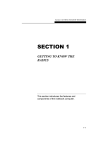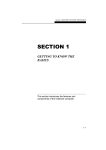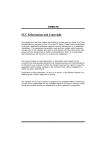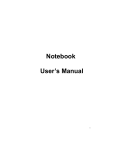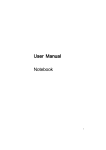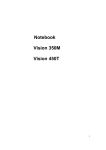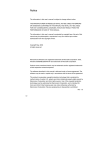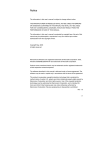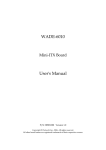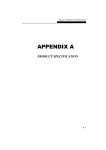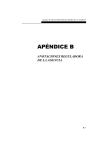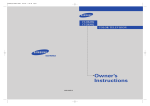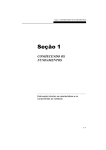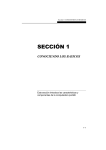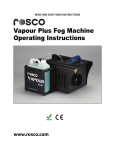Download SECTION 1 - Airis Support
Transcript
Section 1 GETTING TO KNOW THE BASICS SECTION 1 GETTING TO KNOW THE BASICS This section introduces the features and components of the notebook computer. 1-1 USER’S MANUAL Performance Features All-in-one Design The all-in-one design offers built-in floppy drive, hard disk drive, and optical drive (CD-ROM, CD-RW, or DVD-ROM) for the ultimate usability on the go. High Performance Processor The notebook is equipped with a powerful Intel Pentium 4 processor. The processor also supports the 400 MHz front side bus bandwidth for unparalleled performance. Advanced Graphic Engine An integrated AGP-bus 2D/3D video processor for high performance graphics. The integrated SiS650 graphic chip also incorporates an enhanced hardware-based motion-compensation engine which gives you smooth DVD video playback. Advanced 3D graphics capability offers the best realism to PC games. Expandability The system offers upgradable hard disk drive and additional DDR RAM slot for expansion, all owing the user to easily increase the storage and system capacities as t he need arises. Large LCD Display The notebook is equipped with up to 14.1-inch TFT XGA display panel for clear text and brilliant colors. 1-2 Section 1 GETTING TO KNOW THE BASICS Audio Capability The audio playback function supports 3D audio, 64-voices DirectSound, and uses a hardware-based wave-table. Communication Features The system provides built-in Ethernet network adapter for local network and 56K V.90 modem for dial-up network. Firewire (IEEE1394) and USB ports In addition to a full array of built-in I/O ports, the notebook computer offers IEEE1394 for ultra high speed connection to high bandwidth digial video devices and multiple USB ports for peripheral devices. Wireless LAN (Optional) The optional internal Wireless LAN module allows your notebook to connect wirelessly to other 802.11b-enabled systems, devices, or network. 1-3 USER’S MANUAL System at a Glance Top View 1-4 1. LCD Latch The LCD latches lock / unlock the LCD panel. 2. Built-in Microphone The built-in microphone records sound. Section 1 GETTING TO KNOW THE BASICS 3. LCD Display The panel is where the system content is displayed. 4. Keyboard The enhanced 87/ 88-key keyboard is used to enter data. It has an embedded numeric keypad and cursor control keys.(See Keyboard Section for details.) 5. Suspend LED Flashing green light indicates the notebook is in suspend mode. (See the LED Status Indicator Section for details.) 6. Power / Charging Status LED The multi-color LED indicates the power and battery charging status of the notebook. (See the LED Status Indicator Section for details.) 7. Touch Pad with Page Up / Down Function The touch pad is a built-in pointing device with functions similar to a mouse. Use the Page Up or Down key to move one page up or down in Windows. 8. Battery Pack The battery pack is a built-in power source for the notebook. 9. Modem Port This is where you plug the phone jack (RJ-11) for fax/modem functions. 10. Stereo Headphone Jack The stereo headphone jack (3.5-mm diameter) is where you connect the headphones or external speakers. 11. Microphone Jack The microphone jack (3.5-mm diameter) is where you connect a microphone. 12. CD-ROM (or DVD-ROM or CD-RW or Combo) Drive and Disk Eject Button and Manual Eject Key Hole 1-5 USER’S MANUAL If your notebook comes with DVD-ROM / Combo drive, you may play DVD movies or regular CD-ROM disk. If it comes with CD-RW / Combo drive, you may save data onto a CD-R / CD-RW disk. Press the eject button to eject the disk tray. The manual eject keyhole allows you to manually eject a jammed disk. 13. Power / Suspend Button The power/suspend button turns the notebook on and off and it also acts as a system suspend key. Press momentarily to turn on the system. Press and hold for at least 3~4 seconds to turn off the system. How this key behaves can be defined in [Start > Settings > Control Panel > Power Options > Advanced] menu. Press the power / suspend button again to return from the suspend mode. (See Section 3 for more details on system suspend function.) 14. Built-in Speakers The built-in speakers output the sound in stereo. Note: To enable the Internet Hot Key, Email Hot Key, Search Key, and My Favorite Hote Key in Windows O/S other than XP /2000, you must install the special Quick Keys application contained in the factory CD-ROM (d:\Utility \ Qkeys \SETUP.EXE). Be sure you already have setup an ISP account and MS Internet Explore. 1-6 15. Internet Hot Key The `Internet Hot Key` launches the Internet Explore automatically in Windows XP or 2000. In other Windows O/S, you will need to activate a utility program in the factory CD to make use of the key. (See side-note for Quick Keys installation.) 16. LED Status Indicators The LED Status indicators reveal the locking/unlocking of certain key functions and HDD/CD-ROM/FDD drive status. (See the LED Status Indicator Section for details.) 17. Email Hot Key The `Email Hot Key` launches the MS Outlook Express in Windows XP or 2000. In other Windows O/S, you will need to activate a utility program in the factory CD to make use of the key. (See side-note for Quick Keys installation.) Section 1 GETTING TO KNOW THE BASICS Rear View Warning: Do not place any heavy objects on the top of notebook. That may damage the display. 1. Power / Charging Status LED The multi-color LED indicates the power and battery charging status of the notebook. (See the LED Status Indicator Section for details.) 2. Suspend LED Flashing green light indicates the notebook is in suspend mode. (See the LED Status Indicator Section for details.) 3. Floppy Disk Drive and Disk Eject Button This drive is where the floppy disk is read and written. Press the ejection button to eject the floppy disk. 4. Ventilation Grill The fan grill is where hot air is vented. Do not block this airway completely. 5. Infrared Port Infrared Data Association (IrDA) compliant serial infrared port enables 4Mbps (FIR mode) cableless data transfer with IrDA 1.1-compatible external devices. 6. Ethernet / LAN Port The port connects to a network hub via the RJ-45 cable and also conforms to 10/100Base-TX transmission protocol. 1-7 USER’S MANUAL Note: For the system running the Windows NT platform, USB function was not supported. 7. Power Jack (DC-in) The DC-out jack of the AC Adapter connects here and powers the notebook. 8. Kensington Lock Key Hole A Kensington-type security lock latches to this key-hole for anti-theft purpose. 9. Fan Grill The fan grill is where air is drawn to dissipate the internal heat. Do not block this airway completely. 10. USB Port (x2) The Universal Serial Bus (USB) port allows you to connect a wide variety of devices via the USB cable to your notebook at very high data transfer rates of up to 12 Mbps. This port conforms to USB plug-and-play standards. 11. PS/2 Serial Port This is where you connect PS/2-type mouse or keyboard. 12. Firewire / IEEE1394 Port This is a high-speed data port. You may connect any Fire-wire-ready device to this port. 13. TV (S-Video) Port The S-Video port permits you to redirect the screen output to a television set or any analog video playback device. This TV Port is Macrovision-compliant; when DVD movie is played, the output is scrambled to prevent analog recording. 14. External VGA Port The 15-pin VGA analog port is for connecting the external CRT monitor or projector. 15. Parallel Port The 25-pin parallel port connects to any parallel-port devices such as a printer. 1-8 Section 1 GETTING TO KNOW THE BASICS Bottom View 1. Hard Disk Drive Bay This is where the hard disk drive is located. The hard disk drive stores all the system data. The hard disk drive can be upgraded to a larger capacity. (See Section 4 for instructions on a hard drive upgrade.) 2. Battery Pack and Battery Latch The battery pack is a built-in power source for the notebook. Pull on the battery latch to release the battery pack. 3. Ventilation Grills The grills are where air is exchanged in and out of the notebook for internal thermal regulation. Do not block the airway completely. 1-9 USER’S MANUAL AC Adapter 1-10 1. DC-out Connector The DC-out connector docks to the power jack (DC-in) on the notebook. 2. LED Lamp The LED lamp appears green when the unit is plugged into a valid AC source. 3. Adapter The adapter converts alternating current into constant DC voltage for the notebook. 4. AC Plug The AC plug plugs to the AC wall outlet. Section 1 GETTING TO KNOW THE BASICS LED Status Indicators The LED Status Indicator displays the operating status of your notebook. When a certain function is enabled, an LED will light up. The following section describes its indication. System Indicators LED Graphic Symbol Indication Green light indicates the floppy disk drive is being accessed. Green light indicates the hard disk drive and/or CD-ROM drive is being accessed. Green light indicates the numeric keypad is activated. Green light indicates the cap-lock is activated. Green light indicates the scroll-lock is activated. Power Indicators LED Graphic Symbol Indication Blinking green light indicates the notebook is in suspend mode. Blinking orange light indicates the battery is being charged (the system is OFF.) Blinking green-orange light indicates the battery is being charged (the system is ON.) Steady green light indicates the system is ON. Blinking green light indicates the battery power is currently low. 1-11 USER’S MANUAL KeyBoard Features Function (Hot) Keys Graphic Symbol Note: For various system controls, press the Fn (Function) key and the Fx key simultaneously. 1-12 Action System Control Fn + F1 Enters Suspend Mode. Fn + F3 Turns Battery Warning Beep on or off. Fn + F4 Changes Display Mode: LCD-only, CRT-only and LCD&CRT. Fn + F5 Turns Speaker Volume up. Fn + F6 Turns Speaker Volume down. Fn + F7 Increases Display Brightness. Fn + F8 Decreases Display Brightness. Fn + Num Lock Enables the embedded keypad to work in numeric mode. The keys act like numeric keypads in a calculator. Use this mode when you need to do a lot of numeric data entry. An alternative would be to connect an external numeric keypad. Scroll Lock Press the ScrLk key and then press ↑or ↓ to move one line up or down. Section 1 GETTING TO KNOW THE BASICS Windows Keys Your keyboard also has two Windows keys: 1. Start Key This key allows you to pull up the Windows Start Menu at the bottom of the taskbar. 2. Application Menu Key This key brings up the popup menu for the application, similar to a click of the right mouse button. Embedded Numeric Key Pad Press NumLock to enable the embedded numeric key pad. The numbers are printed in upper right corner of a key, in a color different from the alphabets. This key pad is complete with arithmetic operators (+, -, * , /). Press Fn+NumLock to revert to normal character keys. 1-13 USER’S MANUAL Touch Pad (Glide Pad) with Page Up / Page Down Function The built-in touch pad, which is a PS/2-compatible pointing device, senses movement on its surface. As you move your fingertip on the surface of the pad, the cursor responds accordingly. The following items teach you how to use the touch pad: 1. Move your finger across the touch pad to move the cursor. 2. Press buttons to select or execute functions. These two buttons are similar to the left and right buttons on a mouse. Tapping on the touch pad twice produces is similar to clicking the left button of a mouse. 3. Press Page Up / Down button to move up or down a page. Function Left Button Execution Click twice quickly Selection Click once Tap once Drag Click and hold to drag the cursor Tap twice quickly and on the second tap hold finger to the touch pad to drag the cursor Access Context Menu Move One Page Up or Down Right Button Page Up / Down Button Equivalent Tapping Action Tap twice (at the same speed as double-clicking the mouse button) Click once Click upper portion to move up a page Click lower portion to move down Tips on Using the Touch Pad: 1. The double-click speed is timed. If you double-click too slowly, your notebook responds as if you single-clicked twice. 2. Keep your fingers dry and clean when using the touch pad. Also keep the surface of touch pad clean and dry to prolong its life. 3. The touch pad is sensitive to finger movements. Hence, the lighter the touch, the better the response. Heavy touch does not produce better response. 1-14 Section 1 GETTING TO KNOW THE BASICS Display Your notebook uses a high performance 14.1-inch active matrix TFT panel which supports high resolution and multi-million colors for comfortable viewing. Adjusting the Display Brightness Note: To maximize your battery operating time, set the brightness to the lowest comfortable setting, so that the internal back-light uses less power. The notebook uses special key combinations, called hot keys, to control brightness. Press Fn+F7 to increase the brightness. Press Fn+F8 to decrease the brightness. Extending the Life of the TFT Display Device Observe the following guidelines to maximize the life of the backlight in the display. 1. 2. 3. 4. Set the brightness to the lowest comfortable setting (Fn+F8). When working at your desk, connect your notebook to an external monitor and disable the internal display Fn+ F4. Do not disable the suspend time-outs. If you are using AC power and have no external monitor attached, change to suspend mode when not in use. Opening and Closing the Display Panel To open the display, slide the LCD latch to the right and lift up the lid. Then tilt it to a comfortable viewing position. To close the display cover, fold it down gently until the LCD latches click into place. 1-15 USER’S MANUAL Graphic Controller This notebook comes with an integrated AGP-bus SiS650 video graphics accelerator based on a share memory architecture (ie. a portion of the system memory is allocated for graphic engine’s use.) Depending on the total system memory installed, up to 64MB can be allocated as graphic frame buffer. More memory to the graphic subsystem means higher graphic performance; however, as it decreases system memory capacity, overall system performance may suffer. Multimonitor Support The notebook’s display and multimedia capabilities are great for giving presentations. If you prefer, you can also connect an external monitor when giving presentations. This notebook supports LCD and CRT displays in Mirror mode or Multimonitor Mode. In the Mirror mode, both displays show the same content. In the Multimonitor mode, the system allows you to open and work on different applications independently across two display devices (ie. the built-in LCD display and external display.) To enable Multimonitor function, do the following: Warning: To avoid damaging the display, do not slam it when closing. Do not place any object on top of the computer when the display is closed. 1-16 Connect an external CRT or projector to the notebook first and restart the system. After boot-up, right-click the SiS icon on the task tray. Select Display Property and then Display Setting. You will see the Driver Mode Setting dialogue box. In the Driver Mode pull-down menu, select Multimonitor. The system will then ask you to reboot for the function to take place. Section 1 GETTING TO KNOW THE BASICS Audio Devices Your notebook’s Audio is Sound Blaster Pro-compatible. Adjusting the Volume Manually To increase the volume, press Fn+ F5. To decrease the volume, press Fn+F6. Adjusting the Volume in Windows 1. 2. 3. Click the speaker symbol in the taskbar in Windows. Drag the volume control bar up or down to adjust the volume. To temporarily silence the speaker without changing the volume setting, click Mute. Voice Recording You need to use audio processing software to enable the built-in microphone. For example, you may use Microsoft Sound Recorder. When you begin voice recording using the notebook’s built-in microphone, be sure that your mouth is within near distance (no longer than 20 cm) to the microphone. If the record level is too small, you may also increase the microphone gain via the volume control panel in Windows. 1-17 USER’S MANUAL Modem Your notebook comes with a 56K V.90 internal fax/modem and a phone jack (RJ-11), which is located on the left side of your notebook computer. Use a telephone cable to connect the notebook to the telephone wall outlet. Note: Some Windows versions do not support fax function. To enable this function, please install a fax communication software on your PC. Connecting the Modem 1. Plug one end of the phone line into the modem port located on the right side of the notebook. 2. Plug the other end of the line into the analog phone wall outlet. Modem Setting Depending on where your computer is used, you may need to change settings in the modem. Correct setting will allow you to maintain a stable connection in a country where its telecommunication system may be different to others. To change the modem setting, do the following: 1. Go to [Start > Settings > Control Panel] and double-click on Modem Settings icon. You will see a similar dialog box. 2. Click on the pull-down menu and select the country where it is applicable. Click on OK to exit. Warning: The internal modem is intended for use on an analog phone line, also called a POTS (Plain Old Telephone Service) line. This modem cannot be connected directly to a digital telephone line, such as those commonly found in a business office. You may either obtain an analog line or an analog converter compatible with the phone line you’re using. 1-18 Section 1 GETTING TO KNOW THE BASICS Network Adapter Your notebook is equipped with an integrated 10/100Base-TX SiS900 PCI Fast Ethernet network adapter. Connect the active LAN cable to the RJ-45 LAN port located on the left side of the notebook. This allows you to access and transmit data in the local area network. Connecting to the Network Use Unshielded Twisted Pair (UTP) Ethernet cable only. 1. Insert one end of the UTP cable into the network connector until the connector snaps securely into the receptacle. 2. Either connect the other end of the cable to an RJ-45 jack wall outlet or to an RJ-45 port on a UTP concentrator or hub in the network. Cabling Restriction for Networks The following restrictions should be observed for 100BASE-TX networks: The maximum cable run length is 100 meters(m) (328 feet [ft]). For 100-Mbps operation, use Category 5 wiring and connections. Consult Windows manual and / or Novell Netware user‘s guide for the software installation, configuration, operation of the network. 1-19 USER’S MANUAL Wireless LAN (802.11b) Configuration (Optional Device) If your notebook comes with an optional Wireless LAN card, you may use the following as a simple guide to using the wireless function. To show the signal quality meter, do the following: Double tap the Wireless icon on the Taskbar and select Link Info tab. Note: Make sure the Wireless LAN driver is properly installed before using. Be sure to run the SETUP.EXE program in Wireless LAN subdirectory in the factory CD-ROM. Note: Actual dialogue box may be different to what is shown here. 1-20 Section 1 GETTING TO KNOW THE BASICS To configure the Wireless LAN function, do the following: Double tap the Wireless icon on the Taskbar and select Configuration tab. Note: Actual dialogue box may be different to what is shown here. Mode: SSID: Tx Rate: PS Mode: Channel: Select 802.11 AdHoc Mode Enter the same name if two or more than two system are to establish wireless connection. Select Fully Automatic for transmission rate Select Disabled Depending on your region or location, you may enter a specific value. For example, for North America, you may select channel 1 through 11. Go to [Start > Programs > PRISM 802.11 > Country Domain Selection] for a list of suitable channel for a particular region. 1-21 Section 5 TROUBLE SHOOTING SECTION 5 TROUBLE SHOOTING In this section, you will learn how to solve common hardware and software problems. 5-1 USER’S MANUAL Your notebook has been fully tested and complies with the system specifications before shipping. However, incorrect operations and/or mishandling during shipment may cause problems. This section provides a reference for identifying and correcting common hardware and software problems that you may encounter. When you encounter a problem, you should first try to go through the recommendations in this section. Instead of returning the notebook and waiting for repair, you may easily solve the problems by considering the following problems and possible solutions. If the error continues, contact your reseller for service information. Before taking further actions, consider the following suggestions: Check to see if the problem persists when all the external devices are removed. Check to see that the green light indicator on the AC adapter is lit. Check to see the power cord is properly plugged to the wall outlet and to the notebook. Check to see the power indicator of the notebook is on. Check the brightness control on the keyboard if the LCD display appears dim. Check to see if your keyboard is operational by pressing and holding any key. An audible beep indicates the keyboard is functioning correctly. Check for any incorrect or loose cable connections. Make sure the latches on the connectors latch securely on to the receptor end. 5-2 Section 5 TROUBLE SHOOTING Be sure you have not performed an incorrect setting on the hardware devices in the BIOS Setup utility. A faulty setting may cause the system to misbehave. If you are not sure of the changes you made, try to restore all the settings to factory defaults. Be sure all the device drivers are installed properly. For example, without the audio driver properly installed, the speakers and microphone will not work. If external devices such as USB camera, scanner, SCSI card do not function correctly when connected to the system, it is usually the device’s own problem. Consult the device’s manufacturer first. Some software programs, which have not gone through rigorous coding and testing, may cause problems during your routine use. Consult the software vendor for problem solving. Not all peripheral are plug-and-play capable. You need to restart the system with these devices powered up and connected first. Be sure to go to BIOS SETUP and load DEFAULT SETTING after any BI OS updated. 5-3 USER’S MANUAL Audio Problems No speaker output – Software volume control is turned down in Microsoft Sound System. Double-click the speaker icon on the lower right corner of the taskbar to see if the speaker has been muted. Press Fn+F5 Up increase the volume. Most audio problems are software-related. If your notebook worked before, chances are software may have been set incorrectly. Go to [Start > Settings > Control Panel] and double-click the Multimedia icon (or Sounds and Audio Device Property icon). In the Volume page, make sure that SiS 7012 Wave is the playback device. Sound can not be recorded – Double-click the speaker icon on the lower right corner of the taskbar to see if the microphone has been muted or the Line-in level has been lowered to the minimum. 1. Click Options and select Properties. 2. Select Recording and click the OK button. 3. After Click OK button, the recording volume control panel will appear. Go to [Start > Settings > Control Panel] and double-click the Multimedia icon (or Sounds and Audio Device Property icon). In the Volume page, make sure that SiS 7012 Wave is the playback device. 5-4 Section 5 TROUBLE SHOOTING Hard Disk Problems The hard disk drive does not work or is not recognizable If you had just performed a hard disk upgrade, make sure the hard drive connector is not loose and the hard disk drive is also correctly seated. Remove it and reinsert it firmly, and restart your PC. (Refer to Section 4 for details.) The new HDD may need to be partitioned and reformatted. O/S and drivers will need to be re-installed as well. Check the hard disk indicator LED. When you access a file, the LED lamp should light up momentarily. The new HDD may be defective. If your notebook has been subjected to static electricity or physical shock, you may damaged the disk drive. The hard drive is making abnormal whining noises – You should back up your files as soon as possible. Make sure the source of noise is indeed from the hard drive and not the fan or other devices. The hard disk drive has reached its capacity – Run Disk Cleanup utility in Windows. [Start > Programs > Accessories > System Tools > Disk Cleanup] The system will prompt you for what to do. Archive files or programs that you had no longer used by moving them to an alternative storage medium (floppy disk, optical recordable disk, etc.) or uninstall programs that no longer use. The Internet browsers store files in the hard drive as a cache to speed up the performance. Check the program’s Online Help for instructions on decreasing the cache size or on removing temporary Internet files. Empty the Recycle Bin to create more disk space. When you delete files, Windows saves them to the Recycle Bin. 5-5 USER’S MANUAL The hard disk takes longer to read a file If you have been using the drive for a period, the files may be fragmented. Go to [Start > Programs > Accessories > System Tools > Disk Defragmenter] to perform a disk defragment. This operation may take a while. The files are corrupted Run the Error-checking utility in Windows to check the HDD. Double-click My Computer. Right-click C: and select Properties. Click Check Now in Error-checking in Tools. CD-ROM or DVD-ROM Problems The CD-ROM or DVD-ROM drive does not work Try rebooting the system. The disk is damaged or files are not readable. After you have inserted a CD-ROM disk, it may take a moment before you can access its content. The drive dose not read any disks The CD may not be properly seated in the tray. Make sure the disk is firmly seated onto the spindle. The disk is damaged or not readable. The disk can not be ejected Normally, it takes a few seconds to eject the disk. If the disk can not be ejected, it may be mechanically jammed. Straighten out a paper clip and insert it to a tiny hole next to the eject button. This should reject the disk tray. If not, return the unit for repair. Do not forcefully pull on the disk tray. 5-6 Section 5 TROUBLE SHOOTING Display Problems The display panel is blank when the system is turned on Make sure the notebook is not in the Standby or Hibernate suspend modes. The display is turned off to conserve energy in these modes. Press Fn+F7 to increase the screen brightness. Press Fn+F4 to make sure the notebook is not in the CRT-output only mode. The screen is difficult to read Press Fn+F7 to increase the screen brightness. The display resolution should at least be set to 1024x768 for optimal viewing. 1. Go to [Start > Settings > Control Panel] and double-click on the Display icon. 2. Under the Settings page, set screen resolution to 1024x768 and choose at least 256 colors. The screen flickers It is normal if the display flickers a few times during shutting down or powering up. 5-7 USER’S MANUAL Keyboard and Pointing Device (Mouse) Problems The built-in keyboard accepts no input This notebook is designed to use only one keyboard at once time. If you are connecting an external keyboard to the system, the built-in keyboard may not work. Try restarting the system. The built-in touch pad does not work Make sure the internal PS/2 port (pointing device) is enabled (or set to Auto Detect) in the BIOS Setup. Go to Section 2 BIOS Setup for details on how to enable the PS/2 mouse. The built-in touch pad performs eratically Make sure there is no excess perspiration or humidity on your hand when using the touch pad. Keep the surface of the touch pad clean and dry. Do not rest your palm or wrist on the surface of the touch pad while typing or using the touch pad. The characters on the screen repeat while I type. You may be holding the keys down too long while you’re typing. Keep the keyboard clean. Dust and dirt under the keys could cause them to stick. Configure the keyboard to wait longer before the auto repeat feature starts. To adjust this feature, Go to [Start > Settings > Control Panel], and double-click on the Keyboard icon. A dialogue box shows up with the adjustable settings for t he keyboard. 5-8 Section 5 TROUBLE SHOOTING CMOS Problem A message “CMOS Checksum Failure” displays during the booting process Try to reboot the system. If the message “CMOS Checksum Failure” appears during the booting procedure, it may indicate failure of the CMOS battery. If so, you need to replace the battery. This battery normally lasts one to two years on continuous operation. However, for a typical user, the battery lasts three to five years. The battery is of type CR2025 (3V). You may replace it by yourself. The battery is located underneath the keyboard. See Section 4 on how to remove the keyboard. If you are not sure how this i s done, return the notebook to the dealer. Infrared Problems The infrared communication port does not work The system supports fast IR transmission. Windows NT 4.0 does not support infrared devices. Remove any objects that sit between the communicating path. Make sure the communicating devices are not more than 1 meter apart and are aligned in a straight-line fashion. Go to [Start > Settings > Control Panel > System > Hardware > Device Manager] and click Infrared devices icon. If there is a yellow or red mark, the device may have resource conflict. See Windows on-line Help for instructions on how to resolve the device conflict. 5-9 USER’S MANUAL Memory Problems The POST does not show an increased memory capacity when you have already installed additional memory Certain brands of memory module may not be compatible with your system. You should ask your vendor for a list of compatible DIMM. The memory module may not be installed properly. Go back to Section 4 to review the details of this operation. The memory module may be defective. This system’s graphic engine shares a portion of the system’s DRAM as its frame buffer. How much is being shared depends on the setting in the BIOS setup. Go to Section 2 for details. The O/S issues an insufficient memory error message during operation This is often a software or Windows-related problem. Close the application programs you’re not using and restart the system. Otherwise, you have to install additional memory module. For instructions, go to Section 4 Upgrading Your Notebook. 5-10 Section 5 TROUBLE SHOOTING Modem Problems The built-in modem does not respond Make sure the modem driver is loaded properly. Go to [Start > Settings > Control Panel > Modem Settings] and go to Modem Helper. Make sure SmartLink 56K Voice Modem or Uniwill V.90 Modem is listed. Otherwise, click the Add button to add the modem drive, which is located in the factory CD-ROM (or floppy diskette). Go to [Start > Settings > Control Panel > System] and click Device Manager button in the Hardware page to check for possible resource or driver conflict. See Windows on-line help or manual for how to handle such problems. Make sure the phone line the notebook is connected to is working. Connection difficulties Be sure to disable Call Waiting. Be sure to have the correct country setting where your notebook is used. [Start > Settings > Control Panel > Modem Settings > Configuration] In the Country pull-down manual, select the appropriate country setting. Excessive line noise might cause the connection to be dropped. To check this, put the regular phone handset on the line and placing a phone call. If you do hear abnormal noise, try to make the modem connection with a different line or contact your local telephony company for service. Make sure the RJ-11 cable (the one that goes from the modem to the telephone line) is firmly connected to the modem's RJ-11 jack and the telephone line socket. Check the serial port settings. Make sure the hardware and software are referring to the same COM port. Try a different receiver number and see if the problem persists. Be sure the line has a dial tone. 5-11 USER’S MANUAL Network Adapter Problems The Ethernet adapter does not work – Go to [Start > Settings > Control Panel > System > Hardware > Device Manager]. Double-click on Network Adapters and check if SiS 900 PCI Fast Ethernet Adapter appears as one of the adapters. If it does not exist, Windows has not detected the SiS Ethernet adapter or the device driver has not been installed properly. If there is a yellow mark or red cross on the SiS network adapter, there may be a device or resource conflict. Replace / update the device driver from the factory CD-ROM disk or consult Windows manual on how to solve this problem. Make sure the physical connections on both ends of the cable are good. The hub or concentrator may not be working properly. Check to see if other workstations connected to the same hub or concentrator are working. The Ethernet adapter does not appear to operate in the 100Mbps transmission mode – Make sure the hub you are using supports 100Mbps operation. Make sure that your RJ-45 cable meets the 100Base-TX requirements. Make sure the Ethernet cable is connected to the hub‘s socket that supports 100Base-TX mode. The hub may have both 100Base-TX and 100Base-T sockets. 5-12 Section 5 TROUBLE SHOOTING Performance Problems The notebook becomes hot In a 35°C environment, the notebook’s bottom case is expected to reach 50 degrees. Make sure the air vents are not blocked. If the fan does not seem to be working at high temperature (50 degrees Celsius and up), contact the service center. Certain programs that are processor-intensive may increase the notebook temperature to a degree where the notebook automatically slows down its CPU clock to protect itself from thermal damage. The program appears stopped or runs very slowly Press CTRL+ALT+DEL to see if an application is still responding. Restart the notebook. This may be normal for Windows when it is processing other CPU-intensive programs in the background. You may be running too many applications. Try to close some applications or increase system memory for higher performance. The processor may have been overheated due to the system’s inability to regulate its internal heat. Make sure the notebook’s ventilation grills are not blocked. 5-13 USER’S MANUAL Power, Start, and Battery Problems The notebook powers down as soon as it is powered on Battery power may be extremely low. The circuitry prevents a complete power drain, which is not intended for Lithium Ion batteries. Use the adapter to charge it for several hours before trying again. The notebook beeps intermittently When battery charge is low, an audible beep warns you. Press Fn+F3 to turn off the warning beep, if desired. The battery life gets shorter and shorter The battery has a finite life of about 500 charge cycles. If your battery is over one or two years old, it may be time to have it replaced. Try a higher power saving setting in the BIOS or in the Windows Power Management. The battery does not charge Make sure the AC adapter is plugged into a valid power source. The battery charge indicator LED on the notebook should be lit when you plug in the AC adapter. Make sure the battery module is fully inserted in its bay; make sure the battery latch is in locked position. If the battery is operating at a very high temperature, it may not charge. 5-14 Section 5 TROUBLE SHOOTING Printing Problems The printer does not print Make sure the cable connection is secured and the printer is powered up. Run the printer self test to see if it reports any problem. Check if the printer displays any error messages. A paper jam may have occurred. Make sure you have already installed the printer driver. Most printer (using parallel or serial port) problems are software-related. Consult Windows on-line help or contact the printer vendor for assistance. Try rebooting the system with the printer powered up and connected first. The printer does not print what’s on the screen The information displayed on the screen may not exactly be the same as what is printed. If the printer print extra and strange symbols, it is the result of the cache (garbage) in the printer memory buffer. Cancel all the printer tasks and toggle off the printer power switch to clear up the memory buffer. Then, turn the printer back online and print again. Make sure you install the correct printer driver. The printer does not respond to infrared communication See Infrared Problems listed elsewhere in this section. 5-15 USER’S MANUAL Firewire (IEEE1394), USB, and S/PDIF Problems The USB device does not work Windows NT 4.0 does not support USB protocols Check the settings in the Windows Control Panel. Make sure you have installed the necessary device drivers. Contact the device vendor for additional support. The IEEE1394 port does not work Go to [Start > Settings > Control Panel > System > Hardware > Device Manager]. You should see an entry which reads `IEEE 1394 Bus host controllers`. If it does not exist, Windows has not detected the host controller or the device driver has not been installed properly. If there is a yellow mark or red cross on the 1394 host controller, there may be a device or resource conflict. Replace / update the device driver from the factory CD-ROM disk or consult Windows manual on how to solve this problem. Make sure the cable is fully connected. Make sure you have installed the necessary device drivers. Contact the device vendor for additional support. 5-16 Appendix A PRODUCT SPECIFICATION APPENDIX A PRODUCT SPECIFICATION A-1 USER’S MANUAL Processor and Core Logic z z z Processor L2 Cache Core l ogic Intel Pentium 4 @ 1.6~2.0 (or Higher) GHz Intel Net-Burst Architecture Units 478-in FCPGA package 256KB (Williamate, 0.18um) / 512KB (Northwood, 0.13um) SiS650 + SiS961 chipset with graphic, audio, modem, and Ethernet controller integrated 400 MHz Front Side Bus 266MHz DDR interface System Memory z z z Memory Type Defualt Memory Expanssion DDR RAM, PC2100 compatible Display Panel 14.1-inch XGA active-matrix TFT display with up to 16M colors 0MB / 128MB / 256MB / 512MB / 1GB, 2.5-Volt 64-bit bus Total of Two 200-pin DDR SO-DIMM sockets, Max 1GBx2 LCD z Graphics z z z z A-2 Graphic Controller Graphics Memory Sharing Other Features SiS650 integrated 2D / 3D graphics accelerator 4XAGP architecture graphics capability, 3D Graphics Supported Motion Compensation and IDCT Supported for Enhanced DVD Playback Share-memory architecture with up to 50% of the total system memory and/or up to 64MB Direct3D compatible, DirectX compatible VESA DDC1, DDC2B & DDC 3.0 supported. Appendix A PRODUCT SPECIFICATION Storage Capacity z z Hard Disk Floppy Disk Drive 2.5-inch format (9.5mm height) hard disk drive 3.5-inch format with 3 modes; 720KB, 1.44MB, and 1.2MB. Audio z z Audio Chipset Sound Capability SiS961 with integrated audio controller 64-voice Polyphony Wavetable Synthesizer DirectSound 3D accelerator SoundBlaster Pro/16 compatible AC’97 V2.1 compatible Full deplex and independent sample rate converter for audio recording and pl ayback Modem z z SiS961 with Modem Controller integrated with MDC card, MC’97 Modem support Transmission V.90 / K56flex for download data speed up to 56000bps. Speed V.34, V.17, V.29 protocol supported Chipset LAN z z z z z Network Adapter PnP Function Flow Control Speed Seletion Other Features SiS961 with integrated PCI Fast Ethernet function for 10/100Base-TX network standards. Windows 95 / 98 / ME / 2000 / XP Plug and Play compatible Automatic Jam and auto-negotiation for flow control Auto Negotiation and Parallel detection for automatic speed selection (I EEE 802.3u) High performance 32-bit PCI bus master architecture with integrated DMA controller for low CPU and bus utilization Remote Wake-up Scheme supported Hot Insertion supported A-3 USER’S MANUAL Other Hardware Devices z z z z z z CD-ROM CD-RW DVD ROM W-LAN Keyboard Pointing Device 5.25-inch format (12.7mm height) fixed module with 24X speed 5.25-inch format (12.7mm height) fixed module (Optional) 5.25-inch format (12.7mm height) fixed module (Optional) 802.11b Wireless LAN Card, mini PCI interface (Optional) 87 / 88-key touch-type QWERTY keyboard with embedded numeric keypad Touch Pad with Page Up / Down buttons Ports & Connectors z z z z z z z z z z z VGA Port Audio Port Parallel Port Firewire USB Port Infrared Port S-Video Port Modem Port LAN Port Power Port PS/2 Port One 15-pin CRT connector One microphone-in jack & One headphone (audio-out) jack One 25-pinparallel connector One Fireware (IEEE1394) host connector Three USB connectors One FIR LED One S-Video analog output connector One standard phone jack (RJ-11) One standard network connector (RJ-45) One DC-in connector One 6-pin connector Power z Main Battery z AC Adapter z Recharge z A-4 Other Features Li-Ion 9-cell @ 3.7V / 1800mAh, 59.9 W or Li-Ion 12-cell @ 3.7V / 1800mAh, 79.9W Input: Autosensing 100~240V, 50~60Hz Output: 19V, 4.74A, 90W System OFF: 3 HR (100%) System ON: 10 HR (100%) Low Battery Warning Suspend / Resume capability Appendix A PRODUCT SPECIFICATION BIOS z z z z z z PnP Function Self Test Auto Detection Power Management Security Other Features AMI PnP BIOS Power On Self Test DRA M auto-detection, auto-sizing L2 Cache auto-detection Hard disk type auto-detection APM 1.2 (Advanced Power Management) & ACPI 2.0 (Advanced Configuration Power Interface) Two Level Password Protection 32bit access, Ultra DMA, PIO5 Mode support Multi-boot capability Operating System z O/S Microsoft Windows 95 / 98 / ME / 2000 / XP Microsoft NT 4.0 Phsical Specification z z Weight Environment al Limitations 258 (D) x 318 (W) x 38.5 (H) mm 6.6 lbs / 3KG (with CD-ROM & FDD) Operating Temperature: 5 to 35°C (41 to 95° F) Operating Humidity: 20 to 90 percent RH (5 to 35°C) Storage Temperature: -20 to 50°C (-4 to 122°F) Note: Product Specifications are subject to change without notice. A-5 Appendix B AGENCY REGULATORY NOTICES APPENDIX B AGENCY REGULATORY NOTICES B-1 USER’S MANUAL Federal Communications Commission Notice This equipment has been tested and found to comply with the limits for a Class B digital device, pursuant to Part 15 of the FCC Rules. These limits are designed to provide reasonable protection against harmful interference in a residential installation. This equipment generates, uses, and can radiate radio frequency energy and, if not installed and used in accordance with the instructions, may cause harmful interference to radio communications. However, there is no guarantee that interference will not occur in a particular installation. If this equipment does cause harmful interference to radio or television reception, which can be determined by turning the equipment off and on, the user is encouraged to try to correct the interference by one or more of the following measures: Reorient or relocate the receiving antenna. Increase the separation between the equipment and the receiver. Connect the equipment into an outlet on a circuit different from that to which the receiver is connected. Consult the dealer or an experienced radio or television technician for help. Modifications The FCC requires the user to be notified that any changes or modifications made to this device that are not expressly approved by the Manufacture may void the user’s authority to operate the equipment. Connections to Peripheral Devices Connections to this device must be made with shielded cables with metallic RFI/EMI connector hoods to maintain compliance with FCC Rules and Regulations. Declaration of Conformity This device complies with Part 15 of the FCC Rules. Operation is subject to the following two conditions: (1) this device may not cause harmful interference, and (2) this device must accept any interference received, including interference that may cause undesired operation. European Notice Products with the CE Marking comply with both the EMC Directive (89/336/EEC) and the Low Voltage Directive (73/23/EEC) issued by the Commi ssion of the European Community. Compliance with these directives implies conformity to the following European Norms: EN55022 (CISPR 22) Radio Frquency Interference EN50082 (IEC801-2, IEC801-3, IEC801-4) Electro-magnetic Immunity EN60950 (IEC950) Product Safety Canadian Notice This digital apparatus does not exceed the Class B limits for radio noise emissions from digital apparatus as set out in the radio B-2 Appendix B AGENCY REGULATORY NOTICES interference regulations of the Canadian Department of Communications. Le present appareil numerique nemet pas de bruits radioelectriques depassant l es limites applicabl es aux appareils numeriques de Classe B prescrites dans le reglement sur le brouillage radioelectr ique edicte par le Ministere des Communi cations du Canada. Power Cord Requirement The power cord supplied with the notebook AC adapter should match the plug and voltage requirements for your local area. Regulatory approval for the AC adapter has been obtained using the power cord for the local area. However, if you travel to a different area and need to connect to a different outlet or voltage, you should use one of the power cords listed below. To purchase a power cord (including one for a country not listed below) or a replacement ac adapter, contact your local dealer. U.S. and Canada The cord set must be UL-Listed and CSA-Certified. The minimum specifications for the flexible cord are (1) No. 18 AWG, (2) Type SJ, and (3) 3-conductor. The cord set must have a rated current capacity of at least 10 A. The attachment plug must be an earth-grounding type with a NEMA 5-15P (15A, 125V) or NEMA 6-15P (15 A, 250V) configuration. Japan All components of the cord set ( cord, connector, and plug) must bear a `T` mark and registration number in accordance with the Japanese Dentori Law. The2minimum specification for the flexible cord are: (1) 0.75 mm conductors, (2) Type VCT or VCTF, and (3) 3-conductor. The cord set must have minimum rated current capacity of 7 A. The attachment plug must be a two-pole, grounded type with a Japanese Industrial Standard C8303 (15 A, 125 VAC) configuration. Other Countries The cord set fittings must bear the certification mar k of the agency responsible for evaluation in a specific country. Acceptable agencies are: BSI (UK) OVE (Australia) CEBEC (Belgium) SEMKO (Sweden) DEMKO (Denmark) SETI (Finland) EANSW (Australia) SEV (Switzerland) B-3 USER’S MANUAL IMQ (Italy) UTE (France) KEMA (The Netherlands) VDE (Germany) NEMKO (Norway) The flexible cord must be of a HAR (harmonized) type HO5VV-F 3-conductor cord with a minimum conductor size of 0.03 square inches. The cord set must have a current capacity of at least 10 A and a nominal voltage rating of 125 / 250 VAC. Battery Safety The battery pack is intended to use only with this notebook. Do not disassemble the pack. Do not dispose of the battery pack in fire or water. To avoid risk of fire, burns, or damage to your battery pack, do not allow a metal object to touch the battery contacts. Handle a damaged or leaking battery with extreme care. If you come in contact with the electrolyte, wash the exposed area with soap and water. If it contacts the eye, flush the eye with water for 15 minutes and seek medical attention. Do not charge the battery pack if the ambient temperature exceeds 45°C (113°F). To obtain a replacement battery, contact your local dealer. Do not expose the battery pack to high storage temperatures (above 60°C, 140°F). When discarding a battery pack, contact your local waste disposal provider regarding local restrictions on the disposal or recycling of batteries. CAUTION: Danger of explosion if battery is incorrectly replaced. Replace only with same or equivalent type recommended by the manufacturer. Discard used batteries according to the manufacturer’s instructions or local laws. VORSICHT! Explisionsgefahr bei unsachgernazen Austausch der Batterie. Ersatz nur durch denselben oder einem vom Hersteller empfohlenem ahnlichen Typ. Entsorgung gebrauchter Batterien navh Angaben des Herstellers. CAUTION: MODEL N34AS1 FOR USE WITH POWER SUPPLY MODEL Liteon PA-1900-05 ATTENTION: MODEL N34AS1, POUR UTILISER AVEC LE MODELE Liteon PA-1900-05 B-4 Appendix B AGENCY REGULATORY NOTICES Laser Safety The optical drive used with this notebook are certified as a Class 1 laser device according to the U.S. Department of Health and Human Services (DHHS) Radiation Performance Standard and International Standards IEC 825 / IEC 825-1 (EN60825 / EN60825-1). The device is not considered harmful, but the following precautions are recommended: Do not open the unit. Avoid direct exposure to the laser beam. If the unit requires service, contact an authorized service center. Ensure proper use by reading and following the instructions carefully. Do not attempt to make any adjustment of the unit. CLASS 1 LASER PRODUCT APPAREIL A LASER DE CLASSE 1 LASERSCHUTZKLASSE 1 PRODUKT Warning! Do not attempt to disassemble the cabinet containing the laser. The laser beam used in this product is harmful to the eyes. The use of optical instruments, such as magnifying lenses, with this product increase the potential hazard to your eyes. For your safety, have this equipment serviced only by an authorized service provider. LED (Infrared) Safety The infrared port located on the left side of this notebook is classified as a Class 1 LED (light-emitting diode) device according to International Standard IEC 825-1 (EN60825-1). This device is not considered harmful, but the following precautions are recommended: Do not attempt to view the infrared LED beam with any type of optical device. Do not attempt to make any adjustment of the unit. If the unit requires service, contact an authorized service center. Avoid direct eye exposure to the infrared LED beam. Be aware that the beam is invisible light and cannot be seen. CLASS 1 LED PRODUCT LEDSCHUTZKLASSE 1 PRODUKT B-5 USER’S MANUAL Lithium battery warning This computer contains a lithium battery to power the clock and calendar circuitry. CAUTION: Danger of explosion if battery is replaced incorrectly. Replace only with the same or equivalent type recommended by the manufacturer. Discard used batteries according to the manufacturer’s instructions. ATTENTION: Il y a danger d’explosion s’il y a remplacement incor-rect de la batterie. Remplacer uniquement avcc unc batterie du méme type ou d’un type recommandé par le constructer. Mettre au rébut les batteries usagées confor mément aux instructions du fabricant. VORSICHT! Explosionsgefahr bei unsachgemäßen Austausch der Batterie Ersatz nur durch denselben oder einem vom Hersteller empfohlenem ähnl ichen Typ. Entsorgung gebrauchter Batterien nach Angaben des Herstellers. Der Arbeitsplatzbezogene Schalldruckpegel nach DIN 45 635 beträgt 70dB (A) oder weniger. Zum Netzanschluâ dieses Gerätes ist eine geprûfte Leitung zu verwenden. Fûr einen Nennstrom bis 6A und einem Gerätegewicht größer 3kg ist eine Leitung nicht leichter als H05VV-F, 3G, 0.75mm 2 einzusetzen. Die Steckdose muß nahe dem Gerät angebracht und leicht zugängli ch sein. B-6
















































